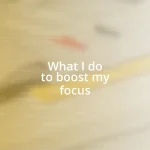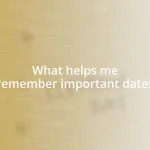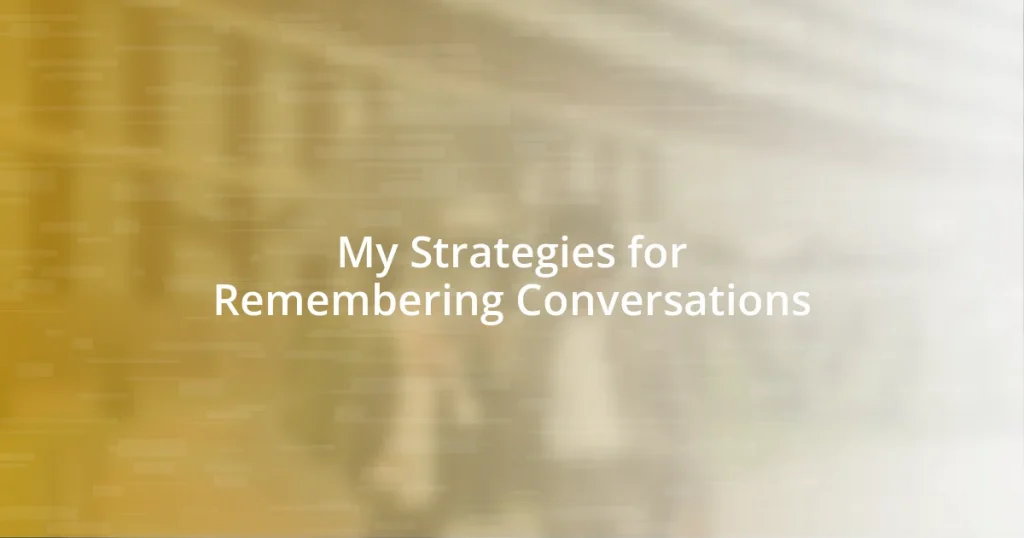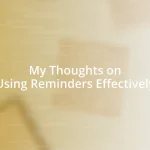Key takeaways:
- Using mnemonic devices like associations, vivid imagery, and the method of loci improves memory retention during conversations.
- Effective note-taking through structured bullet points, personal reflections, and visual aids enhances understanding and recall of discussions.
- Practicing reflection and engaging in follow-up conversations deepen connections and reinforce learning, while utilizing technology like voice memos and note-taking apps aids memory retention.

Using Mnemonic Devices in Conversations
Using mnemonic devices in conversations can transform how we remember key points and ideas. I vividly recall a time at a networking event when I struggled to remember names of people I had just met. To combat this, I used a simple association technique, linking their names to a characteristic or a word that rhymed with their names. It worked wonders!
Have you ever felt overwhelmed by information in a discussion? I often find that creating vivid mental images helps me retain the essence of what was said. For instance, when someone mentions a project deadline, I picture a calendar with a giant red circle around that date. This visual cue makes the deadline memorable and serves as a reminder in our future conversations about progress.
Another effective mnemonic technique I’ve used is the method of loci, which involves associating points of discussion with specific locations in a familiar place, like my childhood home. As I mentally walk through the rooms, I place different conversation points in each space. It’s not only a productive technique but also evokes a sense of nostalgia, anchoring my memories to emotions I can recall any time an associated topic arises.

Taking Effective Notes During Discussions
Taking effective notes during discussions is all about capturing the essence of the conversation while still being present. I remember a time in a team meeting where I began to lose track of the various points being made. That’s when I decided to use a structured approach to my note-taking. I created a simple bullet point system that focused on main ideas and actionable items. This way, I wasn’t just jotting down random sentences; I was actively engaging with the discussion.
In my experience, context is key to effective note-taking. I often choose to include personal reflections right next to notes on key topics. For instance, during a brainstorming session, I would write down my initial reactions alongside the ideas being proposed. This combination not only helps with retention but also makes it much easier to revisit the discussion later and remember the emotions tied to the concepts. Wouldn’t you agree that revisiting those initial feelings can change how we perceive those ideas over time?
To further enhance my note-taking, I’ve discovered the power of visual aids. When I once attended a seminar, I began to sketch diagrams that illustrated the relationships between concepts. It was eye-opening to see how seeing these connections visually made them stick in my mind better than words alone ever could. I found myself recalling those diagrams vividly while discussing the material with others long after the event had ended.
| Note-Taking Method | Advantages |
|---|---|
| Bullet Points | Organizes information clearly and allows for quick referencing. |
| Personal Reflections | Enhances emotional connection and aids retention through context. |
| Visual Aids (Diagrams & Sketches) | Improves memory recall by highlighting relationships between ideas. |

Practicing Reflection After Conversations
Practicing reflection after conversations can be incredibly powerful. There was a time when I wrapped up an extensive discussion with a colleague but felt like I only grasped half of it. To improve my recall, I started to dedicate five minutes post-conversation to jot down my thoughts and feelings about what was discussed. This practice has not only enhanced my memory but also allowed me to pinpoint areas where I need further clarity or engagement for future conversations.
Here are some reflective prompts I often use:
- What were the main points of the conversation?
- How did I feel during the discussion, and why?
- Were there any surprising insights that I need to explore further?
- Did I ask enough questions to fully understand the topic?
- How can I apply what I learned in future interactions?
This approach reinforces my learning and keeps me connected to the conversations I care about. Over time, I’ve noticed that it helps deepen my relationships, as I become more attuned to what others are saying and feeling. Each reflection builds on the last, creating an ongoing dialogue that enriches my understanding.

Engaging in Follow-Up Conversations
Engaging in follow-up conversations is something I consider essential, especially after insightful discussions. Just recently, I had a riveting chat with a mentor about career directions and felt a surge of ideas bubbling inside me. A couple of days later, I reached out to ask a few follow-up questions that had arisen from my reflections. This act not only reinforced what I had learned but also showed my mentor that I valued their input. Don’t you think that a simple follow-up can make a lasting impression?
When I engage in follow-ups, I often share my thoughts about how the previous conversation impacted me. After a conversation about a challenging project, I shot a quick message to a colleague expressing how their views helped shift my perspective. That not only solidified my understanding, but it also opened the door for deeper discussions down the line. How many times have we left important discussions only to feel like there’s more to unpack?
I’ve found that asking open-ended questions in follow-up conversations can lead to richer exchanges. Not long ago, I inquired about a specific point made during a group discussion, which sparked an unexpected conversation about our shared experiences related to that topic. This approach transformed a standard chat into a meaningful dialogue, allowing each of us to learn from one another. Isn’t it fascinating how a few well-placed questions can ignite a whole new level of connection?

Utilizing Technology to Aid Memory
Utilizing technology to aid my memory during conversations has become a game-changer for me. I’ve started using voice memos right after discussions, capturing key insights and my initial reactions while they’re still fresh. It’s fascinating how just speaking out my thoughts helps reinforce what I’ve learned and brings clarity to my memory later on. Have you ever tried recording your thoughts instantly? The immediacy can transform how you remember and process conversations.
Another tool I’ve found immensely helpful is note-taking apps on my phone or laptop. They allow me to organize my reflections, and I can even categorize them by topics or people. For example, after a conversation about a project, I can easily create a document filled with insights that I can revisit or expand upon later. There’s something gratifying about seeing everything laid out neatly, isn’t there? It feels less overwhelming and more like piecing together a puzzle.
I also enjoy using reminders to revisit significant points from conversations. After discussing an idea with a friend, I’ll set a reminder for a week later to check back in and see how my thoughts have evolved. It truly deepens my understanding while also nurturing my relationships. It’s incredible how a little technology can help maintain connections and keep my memory sharp, don’t you think?















